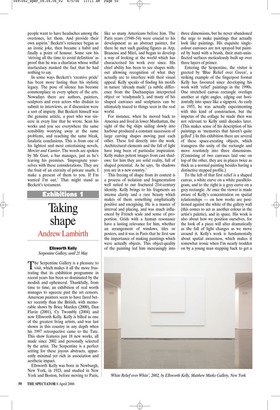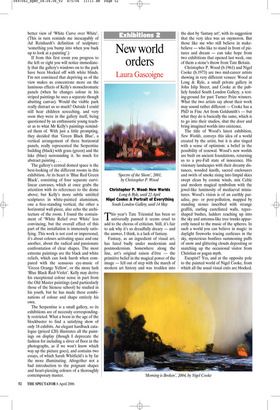Taking shape
Andrew Lambirth
Ellsworth Kelly Serpentine Gallery, until 21 May
The Serpentine Gallery is a pleasure to visit, which makes it all the more frustrating that its exhibition programme in recent years has been so dominated by the modish and ephemeral. Thankfully, from time to time, an exhibition of real worth manages to squeeze past the art censors. American painters seem to have fared better recently than the British, with memorable shows by Brice Marden (2000), Dan Flavin (2001), Cy Twombly (2004) and now Ellsworth Kelly. Kelly is billed as one of the greatest living artists, and was last shown in this country in any depth when his 1997 retrospective came to the Tate. This show features just 18 new works, all made since 2002 and personally selected by the artist. The Serpentine is a perfect setting for these joyous abstracts, apparently minimal yet rich in association and aesthetic impact.
Ellsworth Kelly was born in Newburgh, New York, in 1923, and studied in New York and Boston, before moving to Paris, like so many Americans before him. The Paris years (1948–54) were crucial to his development as an abstract painter, for there he met such guiding figures as Arp, Brancusi and Miró, and began to develop a way of looking at the world which has characterised his work ever since. His chief ability has been to see shapes without allowing recognition of what they actually are to interfere with their visual appeal. Kelly speaks of finding his motifs in nature ‘already made’ (a subtle difference from the Duchampian interpreted object or ‘readymade’), and many of his shaped canvases and sculptures can be ultimately traced to things seen in the real world.
For instance, when he moved back to America and lived in lower Manhattan, the sight of the big ships sailing slowly into harbour produced a constant succession of large curving shapes moving past each other. These fed directly into the work. Architectural elements and the fall of light have long been of particular inspiration. Kelly makes potent images from cast shadows: for him they are solid reality, full of shaped potential. As he says, ‘In shadows you are in a new country.’ This freeing of shape from its context is a process of isolation and fragmentation well suited to our fractured 21st-century identity. Kelly brings to his fragments an intense clarity and a rare beauty which makes of them something emphatically positive and energising. He is a master of interval and placing, and was much influenced by French scale and sense of proportion. Grids with a human resonance have a lasting relevance for him, whether an arrangement of windows, tiles or posters, and it was in Paris that he first saw the importance of making paintings which were actually objects. This object-quality of the painting led him increasingly into three dimensions, but he never abandoned the urge to make paintings that actually look like paintings. His exquisite singlecolour canvases are not sprayed but painted by hand with a brush, their matt-uninflected surfaces meticulously built up over three layers of primer.
Entering the Serpentine, the visitor is greeted by ‘Blue Relief over Green’, a striking example of the fingerpost format Kelly has favoured since developing his work with ‘relief’ paintings in the 1990s. One stretched canvas rectangle overlaps another at right angles, edging out horizontally into space like a signpost. As early as 1955, he was actually experimenting with this kind of construction, but the impetus of the collage he made then was not relevant to Kelly until decades later. (This makes sense of his description of his paintings as ‘memories that haven’t quite gelled’.) In this exhibition there are several of these space-creating objects, which transgress the unity of the rectangle and move resolutely into three dimensions. (Consisting of two canvases laid one on top of the other, they are in places twice as thick as a normal painting besides having a distinctive stepped profile.) To the left of that first relief is a shaped canvas, a white curve on a white parallelogram, and to the right is a grey curve on a grey rectangle. At once the viewer is made aware of Kelly’s concentration on spatial relationships — on how works are positioned against the white of the gallery wall (this comes to act as another colour in the artist’s palette), and in space. His work is also about how we position ourselves, for the look of a piece will alter dramatically as the fall of light changes as we move around it. Kelly’s work is fundamentally about spatial awareness, which makes it somewhat ironic when I’m nearly trodden on by a young man stepping back to get a better view of ‘White Curve over White’. (This in turn reminds me inescapably of Ad Reinhardt’s definition of sculpture: ‘something you bump into when you back up to look at a painting’.) If from this first room you progress to the left or right you will notice immediately that the gallery’s windows on to the park have been blocked off with white blinds. I’m not convinced that depriving us of the view makes us concentrate more on the luminous effects of Kelly’s monochromatic panels (when he changes colour in his striped paintings he uses a separate though abutting canvas). Would the visible park really distract us so much? Outside I could still hear children screeching, and very soon they were in the gallery itself, being questioned by an enthusiastic young teacher as to what Mr Kelly’s paintings reminded them of. With just a little prompting, they decided that ‘Green Black Blue’, a vertical arrangement of three horizontal panels, really represented the Serpentine building (black) with grass (green) and the lake (blue) surrounding it. So much for abstract painting ...
The gallery’s central domed space is the best-looking of the different rooms in this exhibition. At its heart is ‘Blue Red Green Black’, consisting of four separate curvilinear canvases, which at once grabs the attention with its references to the dome above; but Kelly’s more subtle untitled sculptures in white-painted aluminium, one a free-standing vertical, the other a horizontal wall-piece, also echo the architecture of the room. I found the containment of ‘White Relief over White’ less convincing, but the overall effect of this part of the installation is immensely satisfying. This work is not cool or impersonal, it’s about colours activating space and one another, about the radical and passionate confrontation of clear shapes. The most extreme paintings are the black and white reliefs, which can look harsh when compared with the sensuous eye-music of ‘Green Orange Yellow’, or the more lush ‘Blue Black Red-Violet’. Kelly may derive his exceptional colour sense in part from the Old Master paintings (and particularly those of the Sienese school) he studied in his youth, but he has made these combinations of colour and shape entirely his own.
The Serpentine is a small gallery, so its exhibitions are of necessity correspondingly restricted. What a boon in the age of the blockbuster to find a satisfying show of only 18 exhibits. An elegant hardback catalogue (priced £20) illustrates all the paintings on display (though I deprecate the fashion for including a sliver of floor in the photographs, as if we won’t know which way up the picture goes), and contains two essays, of which Sarah Whitfield’s is by far the more illuminating. Altogether not a bad introduction to the poignant shapes and heart-piercing colours of a thoroughly contemporary master.











































































 Previous page
Previous page